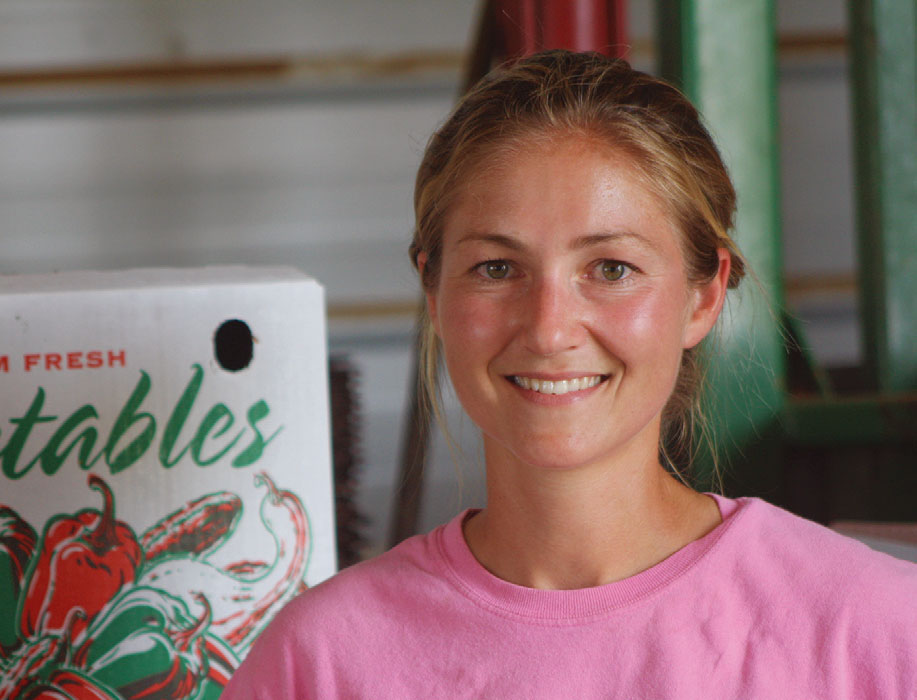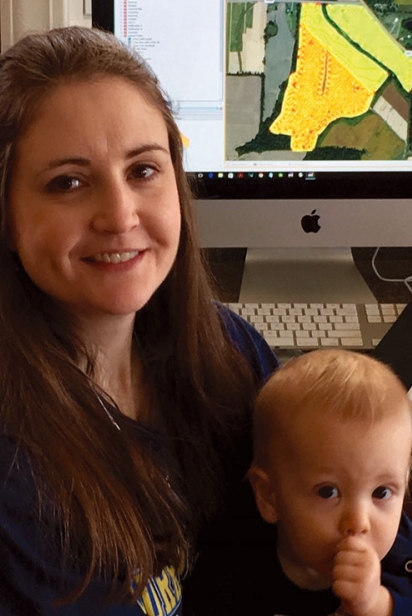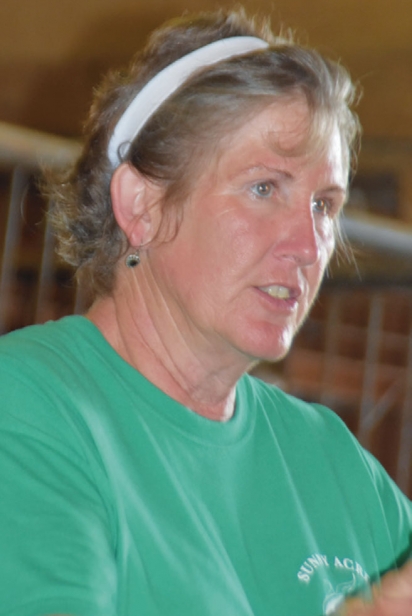The Female Face of Farming
Fewer women running and owning farms, yet they’re finding a new role as the voices and faces of U.S. agriculture
When the USDA conducted its Census of Agriculture in 2012, it found that 30% of the nation’s 3.2 million farmers were women, the same percentage recorded five years earlier. However, just 14% of those women farmers were listed as principal operators of the nation’s 2.1 million farms, a decrease of 6% from 2007 to 2012.
Yet as the use of technology increases on farms, women are finding new opportunities to take on more substantial roles as managers of workers and tech-savvy assistants.
They’re also increasingly becoming the faces of farming as consumers become more interested in the foods they eat. Some women, like Tommee Clark, a microbiologist by day and a part time Louisville farmer, believe women are more at ease talking to inquisitive consumers seeking information about hot button topics such as GMOs and antibiotics used in food production.
“I think women will put themselves out more in the public,” said Clark, who raises beef cattle, corn, soybeans, pigs and goats at Sunny Acres Farm. “When my husband was alive, he was more comfortable doing the farm work and letting me tell the story.”
Given the variety of farms in operation, that story isn’t a single, simple tale. Every farm is unique and all farmers operate their farms differently. According to Rae Wagoner, director of communication for the Kentucky Soybean Board, misinformation about the nation’s food supply is difficult to correct with press releases and ad campaigns. But Wagoner says highly relatable women farmers, who often are also mothers and caregivers, do an exceptional job of saying, “I don’t want to harm my kids with questionable food any more than other moms do. … They have opportunities as actual farmers with the inside track on what’s going on with the foods they raise. They explain what’s really happening with what they produce.”
Groups of women farmers like CommonGround (which is supported by United Soybean Board and the National Corn Growers Association) network to address those sticky issues and to help each other manage the evolving challenges of working the land.
“Farming isn’t a job to them, it’s a way of life,” Wagoner said. “These women are passionate about this in a way that goes beyond just producing good food to eat. They know what they do affects others.”
Here are a few personal stories of women farmers.
Mary Courtney ~ Courtney Farms, Bagdad, Kentucky Farms tobacco, soybeans, corn and vegetables with husband, Shane Mother of four, ages 15 months to 8 years
“Both my husband and I grew up in farming families. So I’ve done a lot of that getting muddy, as you say. We produce a large amount of vegetables for wholesale, and we’ve hired a lot more migrant workers to help. I don’t get as muddy as I used to, and I really miss that component. I oversee what seeds we need to order, what will be planted, and I line up the packaging. But if we need a field [tilled], I can drive a tractor.
“We farm not just for the business, but for the lifestyle. And being a good mother was more important than running a CSA, so when we had our third child, we stopped that in 2012. When you do retail, you’re involved in every transaction, and that really becomes a personal issue with your customers. I do miss the CSA dearly.
“We want people to understand farming, so we have an annual Touch the Dirt Day in the fall for some community outreach. We’ll do a meal based on what’s on the farm, we’ll talk about planting and irrigation, and they can fish on the farm if they like. We also let them meet our migrant workers, which is often a missing piece of the discussion. The majority of caretakers of fruits and vegetables we eat are migrants, and it helps people understand how important they are in providing everyone a source of food.
“Farm wives are very passionate about raising a family and raising food. Whether it’s CommonGround or agricultural leadership [support] like Kentucky Farm Bureau, you meet people and cultivate relationships pretty easily.
“The work is always hard, but it never gets boring around here. Once, when my youngest was 3 weeks old, I was sitting at the kitchen table with a farm business analyst. All of a sudden, both of us look up and see a cow on my back porch looking through the window. I told him, ‘You babysit, I’m going to get the cow.’
“One winter morning, I got in the shower and the phone started ringing. Here I am, pregnant, in the shower, and it’s my husband saying he needed help getting a semi out of the driveway because it was icy and he couldn’t get traction. So I get out of the shower, put my hair in a towel and put on a bathrobe and gumboots. I get on a tractor and try to pull him out, but it wasn’t working. So he told me to get into the semi—which I’ve never driven before—and he got on the tractor and got it out. Some days you just shake your head and say, ‘Tomorrow it’ll be better.’”
Megan Bell ~ Mayfield, Kentucky Mother of four, ages 1 to 8 Farms corn, soybeans, wheat and tobacco with husband, Adam
“With the new emphasis Millennials have on eating properly and wanting their kids to eat well, the role of mothers who are farmers is really starting to emerge. I saw a cover of Successful Farming magazine that read, “Meet Your New Boss,” and it was talking about how women and mothers are becoming their bosses.
“For me part of it is just taking care of our home, but also the bookkeeping and managing the H2A [immigrant] labor. I’m starting become more in charge of our soil data and yield maps. Technology is huge now, and so you’ve got these yield maps that seed companies and fertilizer companies want to see. There is this wealth of information and programs designed to help you take care of the land.
“Since I didn’t grow up on a farm, I had no idea what it meant to look so intently at the Weather Channel. Growing up, I never thought about rain or storms in terms of the damage they can do. Now I can see what weather can do.
“I’ve never had anyone say to me point blank, ‘Why do you farm this way?’ But it can be especially tough sometimes in social media. GMOs are a big topic, and when I’m asked about it, I tell them we do grow GMO products and feed those to animals because I feel they’re very safe. … I feed these things to my own children.
“Oh, and the use of corn for ethanol is another. There could be much more education about it. People don’t realize that the corn used for ethanol is a byproduct used to feed cattle, so there’s no waste involved in it. In a conversation I had with someone about that, they said, ‘You can grow you own fuel?’ Yeah, you can.”
Tommee Clark ~ Sunny Acres Farm, Louisville, Kentucky Farms beef cattle, pigs, corn and soybeans
“The reason many of us are in [CommonGround] is we’re passionate about letting people know where their food comes from. We want to tell our story, not let others tell it for us.
“After my husband died some time ago, I knew it was important to stay busy. I also wanted to make sure my family’s farm survived. I work off the farm [as a microbiologist] to make that happen and to provide an opportunity for the next generation to enjoy it. My daughter now does about 80% of the work while raising a son and having a husband. The farm’s not a job to her, it’s a way of life. It’s not easy, and you do what you have to do.
“I was supposed to be off this one day to go to lunch with a friend of mine. But before I left, I decided to check the cows since we knew one was ready to calve. Well, she was calving and needed some help. So we stopped what we were doing, got our gloves on and helped it.
“There was another time when we were getting ready to go to church and I heard this sound — it’s unmistakable — one of our goats in labor. My grandson Ben went out with me and couldn’t stand the sound and had to go somewhere else. It’s not a pretty sound.
“I work in a hospital, so when people learn that I farm, they ask what I do. They’re curious. But I tend to get, well, tougher questions at a farmers’ market. People have this conception that things have to be grown a certain way, and they say, ‘You’re not raising things right.’ Just because they read something on Internet doesn’t mean that it’s true. Things like selling meat or milk without hormones, those are ones that come up often. They don’t know that every cow has to go through a withdrawal period (from antibiotics) before you can sell milk or meat. And as a microbiologist, I might know a little more about antibiotics than the typical person. It’s just getting the message out there.”
Female Farming Facts
The USDA's 2012 Census of Agriculture reported the following:
» There were 969,672 women farmers working the country's 2.1 million farms.
» Women represent 30% of all farmers nationally.
» Texas had the highest number of women farmers, while Arizona had the highest proportion of women farmers (45%).
» 14% of all U.S. farms list a woman as "principal operator."
» Farms with women operators tend to be smaller than farms overall, holding fewer acres and generating lower sales.
» 82% of farms with a woman principal operator had fewer than 180 acres in 2012.
» 76% of women-operated farms generated less than $10,000 in annual revenue.







